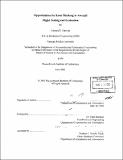| dc.contributor.advisor | Earll Murman. | en_US |
| dc.contributor.author | Carreras, Carmen E. (Carmen Elena), 1978- | en_US |
| dc.contributor.other | Massachusetts Institute of Technology. Dept. of Aeronautics and Astronautics. | en_US |
| dc.date.accessioned | 2005-08-24T20:34:10Z | |
| dc.date.available | 2005-08-24T20:34:10Z | |
| dc.date.copyright | 2002 | en_US |
| dc.date.issued | 2002 | en_US |
| dc.identifier.uri | http://hdl.handle.net/1721.1/8128 | |
| dc.description | Thesis (S.M.)--Massachusetts Institute of Technology, Dept. of Aeronautics and Astronautics, 2002. | en_US |
| dc.description | Includes bibliographical references (p. 73-74). | en_US |
| dc.description.abstract | The application of Lean principles and practices has been shown to help aerospace companies reduce waste and maximize value to help meet the changing demands of the market. The most visible area of influence has been manufacturing, where great strides have been made in cost and cycle time reduction. Recently, the flight testing community has been faced with similar challenges. This paper investigates whether Lean principles can be applied to aircraft flight testing and evaluation to help meet these goals. Specific objectives are to identify opportunities for the implementation of Lean thinking and establish a framework for structured implementation of Lean principles and practices. This study focuses on seven aircraft programs: 737-NG, 767-400, Hawker Horizon, F-22, F/A-18E/F, C-130J, and the T-6A. The programs are analyzed from a programmatic viewpoint to identify where lean practices are currently being used and how lean thinking could further improve the overall flight testing process. Additionally, a detailed examination is performed on the day-to-day activities to identify the daily sources of waste and their impact on the program. The detailed analysis focuses on flutter testing as a surrogate for the entire testing program. A total of 90 flights were analyzed. Data collected from the case studies fits well into the value-creation framework established in Lean Enterprise Value. Each of the phases of the framework - value identification, value proposition, and value delivery - are discussed as they relate to flight testing. Many examples of the application of lean principles and practices as well as opportunities for implementation are presented in the value delivery phase. Opportunities were identified in: coordination of the systems engineering value stream, coordination with other test aircraft and necessary support functions, and management of the daily test operations. This preliminary study indicates that Lean thinking can be applied to flight testing. The guiding principles of well-run testing programs paralleled those of Lean. Additionally, there are many instances where Lean thinking would provide an opportunity to eliminate waste and improve efficiency. | en_US |
| dc.description.statementofresponsibility | by Carmen E. Carreras. | en_US |
| dc.format.extent | 80 p. | en_US |
| dc.format.extent | 5833963 bytes | |
| dc.format.extent | 5833724 bytes | |
| dc.format.mimetype | application/pdf | |
| dc.format.mimetype | application/pdf | |
| dc.language.iso | eng | en_US |
| dc.publisher | Massachusetts Institute of Technology | en_US |
| dc.rights | M.I.T. theses are protected by copyright. They may be viewed from this source for any purpose, but reproduction or distribution in any format is prohibited without written permission. See provided URL for inquiries about permission. | en_US |
| dc.rights.uri | http://dspace.mit.edu/handle/1721.1/7582 | |
| dc.subject | Aeronautics and Astronautics. | en_US |
| dc.title | Opportunities for lean thinking in aircraft flight testing and evaluation | en_US |
| dc.type | Thesis | en_US |
| dc.description.degree | S.M. | en_US |
| dc.contributor.department | Massachusetts Institute of Technology. Department of Aeronautics and Astronautics | |
| dc.identifier.oclc | 51687456 | en_US |
